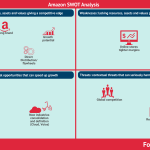Amazon SWOT Analysis In A Nutshell

Amazon is among the most diversified business model in the tech industry. The company is well-positioned to dominate e-commerce further. And while its online stores have tight profit margins, Amazon still unlocks cash for growth, while consolidating its dominance in the cloud and grabbing new opportunities like voice.
Amazon strengths
[image error]Amazon has a diversified business model. In 2019 Amazon posted over $280 billion in revenues and over $11.5 billion in net profits. Online stores contributed to over 50% of Amazon revenues, followed by Physical Stores, Amazon AWS, Subscription Services, Third-party Seller Services, and Advertising revenues.
Strong brand: Amazon is the most valuable brand on earth. Launched as a bookstore, it eventually became the “everything store,” and from there, it dominated several other industries. Amazon today is exceptionally well-positioned to keep expanding its online stores’ capabilities. Diversified business model: Amazon is among the tech giants who have the most diversified business model. Spanning from e-commerce to cloud, advertising, and more.Massive growth potential: While Amazon passed the trillion-dollar in market capitalization, it is also positioned on several markets that might become trillion-dollar industries. Direct distribution/flywheels: Amazon enjoys massive flywheel effects thanks to its built-in growth mechanisms, which made it the company we know today.
[image error]The Amazon Flywheel or Amazon Virtuous Cycle is a strategy that leverages on customer experience to drive traffic to the platform and third-party sellers. That improves the selections of goods, and Amazon further improves its cost structure so it can decrease prices which spins the flywheel.
Amazon weaknesses
[image error]Amazon is a profitable company. Its operating income and net income passed $12.4 billion and $10 billion respectively in 2018. The operating income was driven primarily by Amazon AWS, contributing $7.29 billion. Amazon has been consistently profitable since 2015 when it posted 596 million in profits.
Online e-commerce has tighter margins: the online e-commerce side of Amazon has tighter profitability compared to other parts of the business. However, the same e-commerce is the platform around which the company has been developed. Thus, it needs to be judged based on cash flows.
Amazon threats
[image error]Google and Amazon are fighting for dominance between e-commerce and advertising.
Where Google has a monopoly in the search market. Amazon might gain a monopoly in product searches.
In 2020, Google opened its Google Shopping for free to contrast Amazon dominance on e-commerce and prevent Amazon from taking more space in the digital advertising industry, the core business fo Google.
Global competition and tech wars: As tech giants try to consolidate and keep the dominance in their industries, they also move in adjacent markets, thus overlapping part of their value proposition to consumers. This triggers expensive tech wars that might end up causing losses for Amazon as well.Regulation: Amazon has become a massive company made of many moving parts. This raises the question of whether it makes sense to break it up to prevent the company from abusing its dominant position in several industries (e-commerce, cloud voice).
Amazon opportunities
[image error]Amazon runs a platform business model as a core model with several business units within. Some units, like Prime and the Advertising business, are highly tied to the e-commerce platform. For instance, Prime helps Amazon reward repeat customers, thus enhancing its platform business. Other units, like AWS, helped improve Amazon’s tech infrastructure.
Global expansion: While Amazon has been growing at a crazy speed, its space for global expansion is still wide.New industries consolidation and definition: As Amazon expands, it also develops new markets. For instance, Amazon is a key player in the cloud industry. And it’s a dominant player in the voice industry, among the most interesting in the coming years.
[image error]In 2019, Alphabet’s (Google) Cloud Business was an almost $9 billion unit within Alphabet’s Google overall business model; to gain a bit of context; Microsoft intelligent cloud netted nearly $39 billion and Amazon AWS $35 billion in the same year.
Read more:
Amazon Business ModelWhat Is the Receivables Turnover Ratio? How Amazon Receivables Management Helps Its Explosive GrowthAmazon Case Study: Why from Product to Subscription You Need to “Swallow the Fish”What Is Cash Conversion Cycle? Amazon Cash Machine Business Model ExplainedWhy Is AWS so Important for Amazon Future Business Growth?Amazon Flywheel: Amazon Virtuous Cycle In A NutshellAmazon Value Proposition In A NutshellWhy Amazon Is Doubling Down On AWSThe Economics Of The Amazon Seller Business In A NutshellHow Much Is Amazon Advertising Business Worth?What Is the Cost per First Stream Metric? Amazon Prime Video Revenue Model ExplainedJeff Bezos Teaches You When Judgment Is Better Than Math And DataAlibaba vs. Amazon Compared in a Single InfographicAmazon Mission Statement and Vision Statement In A NutshellGoogle Vs. Amazon: The Latest Move For World DominationGoogle Q1 Profit 2020: Mobile Traffic, Youtube Ads, Youtube Memberships, And Cloud Saved The Day (For Now)Third-Party Sellers And Amazon’s Platform-First Business, Will It Last?
The post Amazon SWOT Analysis In A Nutshell appeared first on FourWeekMBA.
Published on May 20, 2020 15:23
No comments have been added yet.



